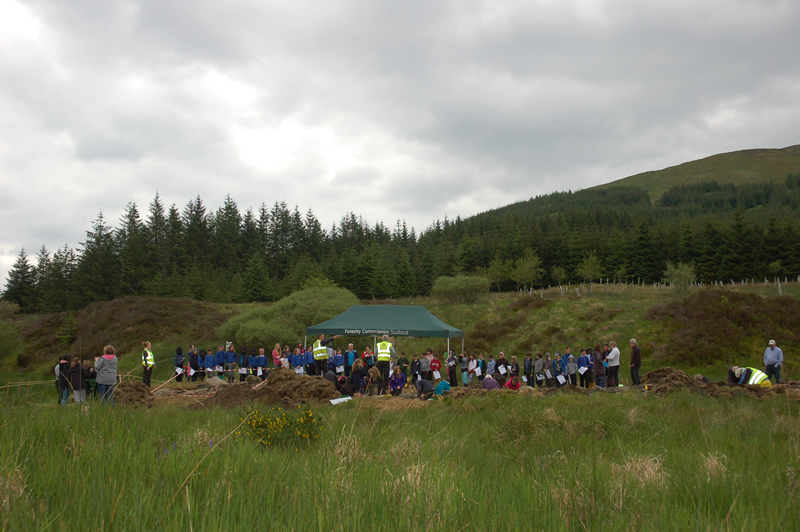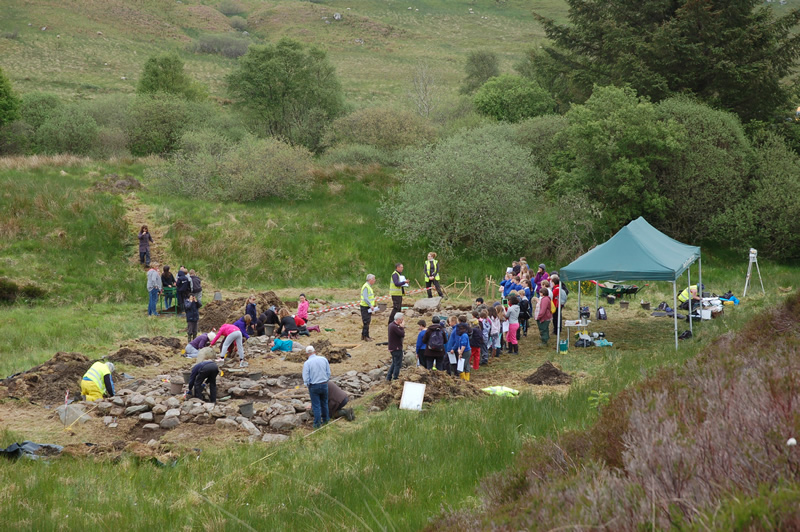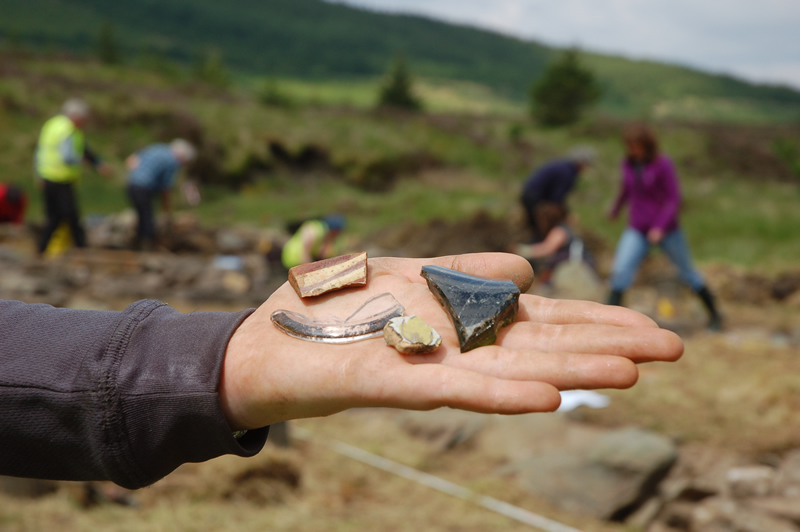A GUARD Archaeology community excavation in Argyll has recently completed the first such excavation of a Drovers' Inn anywhere in Scotland, revealing a snapshot of how it was used before it was abandoned almost 200 hundred years ago.
On the road to Glendaruel in Argyll are the ruins of 'Tigh Caol', an old inn on the edge of a droving route on the Cowal Peninsula area near Strachur. The inn at Tigh Caol first provoked the interest of GUARD Archaeology Chairman, Donald Adamson, when he was undertaking a PhD at the University of Glasgow on the archaeology of cattle droving (and grain export) from the Highlands in the seventeenth and eighteenth centuries. Perhaps the single greatest catalyst for change in the Scottish Highlands immediately before and during the Agricultural Improvement of the eighteenth century was the growing export of black cattle in huge numbers. The archaeology of this trade has hitherto been much undervalued.
The Tigh Caol dig started on Monday 26 May 2014 with fantastic support from the Strachur and District Local History Society and volunteers from local communities. Donald, together with GUARD Archaeology Project Manager Warren Bailie and five Glasgow University students got stuck straight in by opening the proposed excavation trenches, the positions of which had been discussed almost a year previously; so the anticipation was palpable. It quickly became clear that this, at first glance, simple rectangular dry-stone built building had a lot more going on.
A trench across the west gable end leading east into the structure revealed a fairly central, intricate, stone-paved hearth arrangement with charcoal rich deposits in the periphery representing the repeated raking out of the fire and discarded flints that would have been used to light it. This hearth lies within a room measuring approximately 4 m by 5 m, the size of your average living room or kitchen today. A low stone bench or platform was built against the north wall within this room. One can easily picture a drover or traveller resting here with their feet up by the central fire and a drink in their hand over 200 years ago.
The larger main room of the Tigh Caol Inn appears more open and there around a central hearth was a beaten earth floor with some organic deposits. Here among the wall collapse there is a substantial dressed lintel stone and other stones at floor level displaying signs of burning.
The findings from the Tigh Caol dig so far is in keeping with the suspected eighteeenth to early nineteeth century date. The team recovered multiple shards of eighteenth century bottle glass and various pottery wares such as delft, Staffordshire Slipware and other hand painted white glazed fine-wares. One of the star finds are shards, including a base and rim, of a fine clear glass goblet of probable eighteenth century date, indicating that this inn afforded fairly high quality items to visiting drovers. The team also found a nineteen century coin potentially marking the point when the inn went out of use.
Near the drover's track which approaches from the south, on the edge of the nearby burn, the team's metal detectorist, Jim Conquer, also recovered a copper alloy horse harness keep with a double thistle design.
This may have slipped off when a drover's horse was taken for water or perhaps when it was traversing the burn.
Pupils from the local Strachur, Kilmodan, Toward, Tighnabruaich and Sandbank Gaelic Medium primary schools helped uncover the walls and turned up some eighteenth century bottle glass. There were a total of 100 pupils assisting, all of whom had a chance to dig, sieve, metal detect, plan and of course have fun!
As one of the teachers, Catriona MacPhail, said, 'My class had a fantastic time at the dig and would happily have stayed all week digging, sieving, drawing plans and metal detecting. It was tremendously helpful to us with our own mini-project at Allt na Blathaich, which was probably abandoned around the same time and for the same reasons as Tigh Caol. It was also useful to show the children how the map skills and maths that they learn in class is actually used by archaeologists in their everyday work. Hearing people refer to the "south wall" and feeling the sun at their backs at lunchtime helps with our orienteering skills too! They were all delighted to know that they were finding pieces of glass that no-one had handled since they got broken over 200 years ago.'


